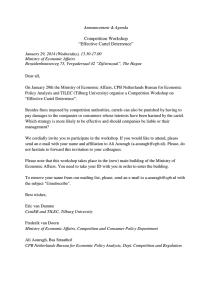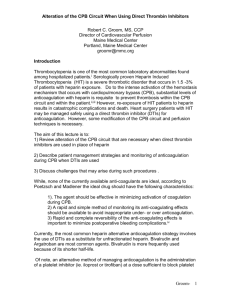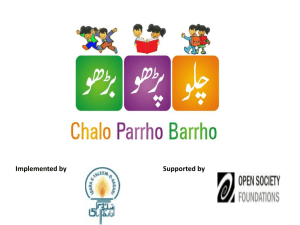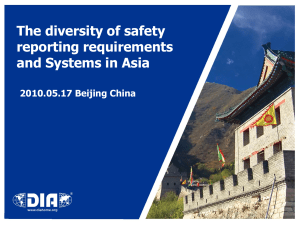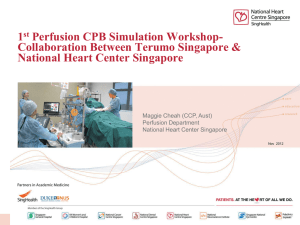Pediatric Cardiopulmonary Bypass: Anesthesia Guide
advertisement
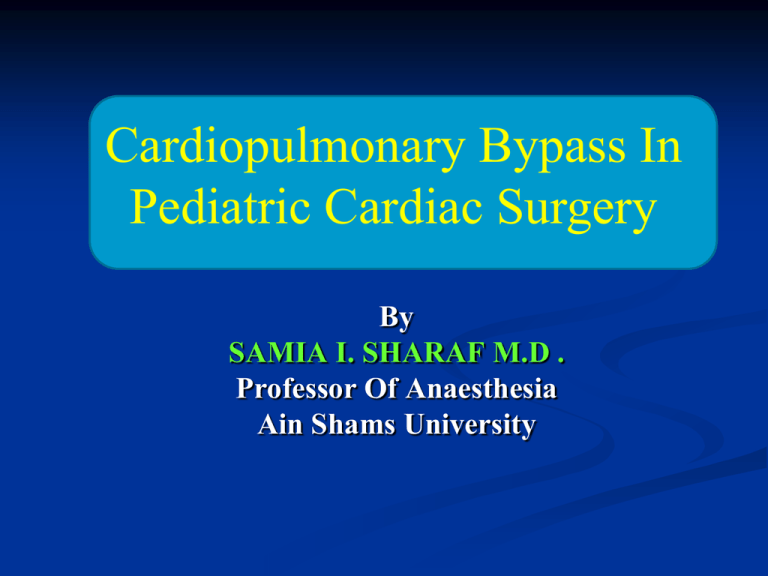
Cardiopulmonary Bypass In Pediatric Cardiac Surgery By SAMIA I. SHARAF M.D . Professor Of Anaesthesia Ain Shams University Cardiopulmonary Bypass For Pediatric Cardiac Surgery Rational for use of cardiopulmonary bypass in cardiac surgery ** Provides clear surgical field for cardiac manipulations during open heart surgery ** Provides enough flow to maintain sufficient tissue perfusion Components Of Cardiopulmonary Bypass Cardiopulmonary Bypass Circuit Arterial cannula Main pump Roller Centrifuge oxygenator •Membrane •Flow rate 0-200ml •HCT 15-40% •Temp. 10-38c Heat exchange PATIENT Venous cannula Venous reservoir Accessory pump filter Accessory pump Cardiot omy circuit for blood suction Left vent Arterial cannulae Pediatric straight tip with ¼ inch connection site vented Non vented Curved tip cannulae Venous Cannulae Right angle metal tip cannulae Thus, cannulation for cardiopulmonary bypass should provide: o Adequate flow. o Unobstructed drainage. o Perfusion and drainage of all organs. o Unobstructed field. Venting : Left ventricular venting is necessary in infants and neonates because of their greater bronchial collateral flow ( up to 30% of neonatal circulating blood volume may be held within suction system ) . Pediatric Left Heart Catheter Child Nomogram What Anesthiologist Should Know About Pediatric CPB Physiology of CPB Conduct of CPB Pathophysiologic effect of CPB Strategies Optimizing CPB Physiology Of Cardiopulmonary Bypass PRIMING : NEONATES : Large prime/ blood volume ratio > 200 – 300 % of blood volume PEDIATRIC : Total prime volume 500 – 1200 ml Priming Should Be A Balanced Electrolyte Solution Constituents Of Prime For Pediatric Extracorporeal Circuit Plasmalyte – A Or Normosmol-R (PH 7.4) Red packed cells or fresh whole blood 400-1200 Ml 0-600Ml Mannitol 15% 1g/Kg Albumin 25% 50Ml NaHCO3 25mmol/Kg CaCL2 30mg/Kg Heparin 2U/ml Prime Total volume 700-1200 ml Hemodilution : Due to priming volume Priming volume depends on size of venous reservoir , oxygenator and tubing Degree of hemodilution (predicted HCT on bypass ) is a matter of prime volume , patient blood volume and HCT HCT below < 20-25% on bypass consider addition of blood to bypass circuit N.B: PHCT = PtBV x PtHCT PtBV + PrimeBV PHCT= Predicted Pump HCT PT. BV = Patient Calculated Blood Volume PT.HCT = Patient HCT PRIME BV = Total Priming Volume The Amount Of Blood Required To Be Added To The Prime Is Calculated As : Prime RBC Volume = ( On Bypass HCT) X ( Pt.BV + Prime BV ) – ( Pt. RBC Volume ) Effect Of Hemodilution systemic vascular resistance improve blood flow through microcirculation in presence of hypothermia Loss of oncotic activity tissue oedema Hemodilution of coagulation factors Exagerates release of stress hormones, complement and white cell and platelet activation Pump Flow Rate Pump Flow Rate Based on body weight and maintenance efficient organ perfusion *Venous saturation *Arterial blood gases *Acid base base balance Patient weight kg Pump flow rate ( ml/kg/min) 0-7 120-200 7-10 100-175 10-20 80-150 > 20 50-75 Determinants of optimum flow rate is based on systemic oxygenation & acid base balance.These data are less useful during deep hypothermia in which metabolism is severely reduced and cerebral autoregulation is lost Anticoagulation : * Heparin : 300 – 400 u/kg * ACT >480 seconds * Plasma Heparin concentration Hypothermia Necessary to tolerate reduction of flow rate on CPB Protective effect of hypothermia : (1) metabolic rate & O2 consumption lead to tolearance of low flow rate of CPB without affecting global oxygenation (2) Preserve high energy phosphate (3) calcium entery into cell & decrease cell membrane permeability Classification Of Pediatric Perfusion According To Degree Of Hypothermia Normothermic Perfusion Moderate Hypothermic Perfusion Profound Hypothermic Perfusion Older children Simple cases Need high flow rate and HCT 25-30c Older children Repair of VSD, F4,SAM Low flow rate Neonate Temp. below 18c Complex surgery Low flow rate Circulatory Arrest Neonate Cannulae off field Complex surgery ( aortic arch ) Excellent surgical condition Conduct Of CPB Anticoagulation Cannulation Initiation Of CPB ( Separation From Anaesthesia Machine ) Maintaining CPB ( Period Of Surgical Repair ) Ending CPB ( Weaning ) Reversal Of Anticoagulation & Removal Of Cannulae Is Anesthetist Presence Is Required During CPB Is It Lunch Break For Us ? Role Of Anaesthetist During CPB 1. Traditional anaesthesia goals 2. Monitoring 3. Participation in risk management 4. Weaning from CPB I. Traditional anaesthetic goals 1) 2) 3) 4) Hypnosis Analgesia Amensia Muscle relaxation Effects of CPB on anaesthetic agents Pharmacokinetics of drugs change due to : • Hemodilution • perfusion to peripheral tissue • Hypothermia Pharmacokinetic changes during CPB CPB Hemodilution Light planes of anaesthesia Counterbalanced by Plasma proteins Perfusion to periphery Hypothermia protein binding redistribution of new drugs metabolic rate plasma free to bound drug level mobilization of stored drugs ½ life of drug ( 2-3 folds ) availability to cross B.B.B liver metabolism of drugs keep plasma drug level as before CPB Effects Of CPB On Specific Anaesthetic Agents Opioids : • High dose opioids : * Showed flat plasma drug level during CPB opioid tisue level is constant at onset of bypass * Need no opioid supplement during CPB • Opioid infusion : Drug level along course of CPB and during rewarming • Fast track technique & warm CPB: • Normothermia , high flow rate , low doses of opioids have dilutional effect on drug level • Require opioid supplementation Amensic Agents • Rewarming period after hypothermia is time of recall • Recall is uncommon at teperature below 30 c • Supplement of benzodiazepines ( midazolam ) is required • Dose of 0.1 – 0.15 mg/kg during rewarming Neuromuscular Blocking Agents Drug level is affected by hemodilution at onset of CPB because of : 1) Water soluble drugs 2) Ionized 3) Not bound to plasma proteins Require addition doses at onset of CPB Inhalational agents Lesser influence of CPB on uptake, distribution & elimination Check List For Initiation Of CPB 1) ACT adequately elevated 2) Observe face and neck for colour and venous engorgement 3) Ventilation continued till stable flow rate 4) Turn off ventilation vaporizers and I.V infusion when stable flow rate (2) Monitoring of CPB Machine Performance Pump Pressure Adequate Perfusion Biochemical Variables Arterial Pao2 , Paco2,PH K+ HCT (Arterial Line Pressure ) Pump Flow Rate Temperature Venous Blood Saturations MONITORING OF PATIENT 1) 2) 3) 4) 5) 6) 7) Blood pressure Urine output ECG BIS Cerebral monitoring Blood glucose level Anticoagulation Participation In Risk Management During CPB 1) Patient movement during CPB 2) Help in urgent seinario e.g pump circuit failure and o2 failure which requires immediate separation of CPB 3) Acute dissection of aorta from cannulation 4) Massive air embolism Weaning From CPB When to wean ?? • Surgical repair is complete • Patient temperature is 37c • Balance of physiologic parameters ** Correct acidosis ** K+ ** Correct ca++ ** HCT 25-30 % OR preop. Level How To Wean From CPB 1) Ask perfusionist about fluid balance i.e how much blood is left in CPB 2) Ask perfusionist about venous oxygen saturation 3) Start lung ventilation 4) Reduce flow rate of CPB gradually 5) Fill the heart 6) Off bypass 7) Observe and optimize hemodynamics 8) Reverse Heparin & remove the cannulae 9) Start the hemostasis Factors That May Result In Failure To Wean From CPB PATHOPHYSIOLOGIC EFFECT OF CPB ON BODY ORGANS Contact With CPB Circuit 3 Hs Hypothermia Hemodilution Hypoperfusion Exclusion Of Pulmonary Circulation Causeds Of Pathophysiologic Consequences Of CPB ( Inflammatory Stress & Organ Dysfunction ) Decrease Renal & Hepatic Clearence Of Stress Hormones Non Pulsatile Flow Decrease Depth Of Anaesthesia Pathophysiologic Consequences Of CPB Myocardial effect Systemic & pul. Hypertension Postop. Bleeding Increase catecholamine release Complement activation Cytokine release Prostaglandin Pul.Vascular reactivity Thromboxane Renal Dysfunction Pulmonary endothelial damage (Pul.Dysfunction) Strategies For Optimizing The Use Of CPB In Neonates , Infants & Pediatrics (1) Identification of patients at risk of mortality from bypass o o o o Patients requiring surgery in the 1st. Month are at risk Small size infant (1800 grams) Infants with reduced LV function Multiple congenital anomalies with CHD (2) Use of methyl predinsolone (3) Leukocyte depleted blood in the circuit and leukocytic blood filter (4) Minimize CPB circuit : low volume oxygenator, short tubes , and small diameter tubes. (5) Vaccum assisted venous drainage (6) Bicompatible coated circuit (Heparin coated circuit) ULTRAFILTRATION It is a hemofiltration technique that passes blood through a semipermeable membrane filter and using a transmembrane pressure gradient , remove water , electrolytes and other substances of small molecular size . Types Of Ultrafiltration Conventional ultrafiltration Removal of fluids during bypass Difficult in neonates because of small circuit Modified ultrafiltration ( MUF) Effective method in neonates and sick infants Performed after CPB completion Remove fluid rich in inflammatory mediators. Presence of anesthetist is essential during CPB It is not a lunch break Someone has to be there
